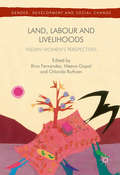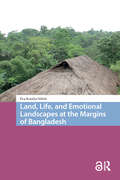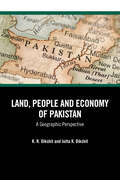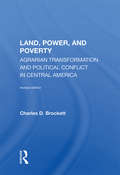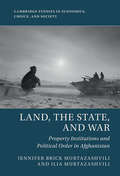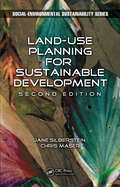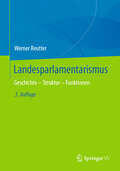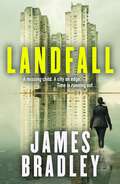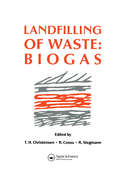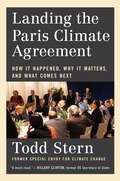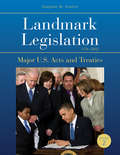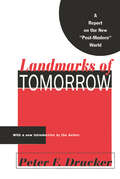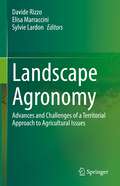- Table View
- List View
Land, Capital and Extractive Frontiers: Social Conflict and Ecological Crisis in the Senegal River Delta (Alternatives to Capitalism in the 21st Century)
by Maura BenegiamoThis book examines ‘land-grabbing’ - its colonial roots and the fraught relationship between capital and nature amidst the current global socio-ecological crisis. Through ethnographic and archival research, Maura Benegiamo investigates an Italian company’s acquisition of 20,000 hectares in Senegal’s River Delta for agrofuel production and delves into the struggles of pastoral communities affected by the project. Through this landmark case, the book shows how European energy and global food security policies are reshaping rural spaces, expanding agrarian extractivism in sub-Saharan Africa. By shedding light on how contemporary capital–nature relationships perpetuate socio-ecological crises and colonial models, the book highlights the enduring forms of opposition to these processes. At the heart of these struggles lies a crucial question: how can we understand today’s crises while reclaiming alternative ways of living, producing and inhabiting the land?
Land, Labour and Livelihoods: Indian Women's Perspectives (Gender, Development and Social Change)
by Orlanda Ruthven Bina Fernandez Meena GopalThis book brings together a unique collection of theoretical and empirical analyses of women’s access to land, labour and livelihoods in contemporary India. The authors recognize that gender relations must be viewed intersectionally, along with other social relationships such as caste, ethnicity, religion, sexuality and age, in order to inform an integrated analysis of women’s persistent disadvantage in India. The chapters examine a diverse range of rural and urban livelihoods within sectors such as tea plantations, nursing, hair salons, sex work and waste collection. Documenting the shifts in these sectors in the context of economic liberalization, the authors offer insights on the challenges of development interventions as women negotiate shifts in their livelihood options. Written to engage, the contributions to this book will be of interest both to the general reader and to academics and practitioners in development and gender/women’s studies.
Land, Life, and Emotional Landscapes at the Margins of Bangladesh (Transforming Asia)
by Éva Rozália HölzleDrawing on two years of ethnographic research in the north-eastern borderlands of Bangladesh, this book focuses on the everyday struggles of indigenous farmers threatened with losing their land due to such state programmes as the realignment of the national border, ecotourism, social forestry and the establishment of a military cantonment. In implementing these programmes, state actors challenge farmers’ right to land, instituting spaces of violence in which multiple forms of marginalisation overlap and are reinforced. Mapping how farmers react to these challenges emotionally and practically, the book argues that these land conflicts serve as a starting point for existentially charged disputes in which the survival efforts of farmers clash with the political imaginations and practices of the nation-state. The analysis shows that losing land represents more than being deprived of a material asset: it is nothing less than the extinction of ways of life.
Land, People and Economy of Pakistan: A Geographic Perspective
by K. R. Dikshit Jutta K. DikshitThe book unravels the complexity of Pakistan’s physical terrain, from the Arabian Sea coast to the Himalayan heights, focusing on its bio-climatic environment. While throwing light on the evolution of societal organisation and the nature and intensity of economic enterprises, it discusses the human response to the natural milieu and the way natural resources have been harnessed.This volume discusses the distribution of natural resources and deciphers the evolutionary development of manufacturing, transport and trade, the main non-agricultural enterprises, and looks at the potential for their growth. It provides an overview of the country`s economy and its fluctuations through different political regimes. It also investigates the country’s diverse social, linguistic, and ethnic composition. A habitat study, incorporating villages and towns and their numerical and spatial distribution and also the hierarchical organisation of rural society have received a special focus in the book.The book, with its qualitative and quantitative information, will be useful to students, teachers and researchers studying physical geology, climatology, hydrology, soil science, environmental studies, archaeology, sociology, economics, demography, area studies and regional development studies. It will also be an indispensable companion to professionals in floral-landscaping, habitat study, administrators, and policymakers.
Land, Power, And Poverty: Agrarian Transformation And Political Conflict In Central America (Thematic Studies In Latin America)
by Charles D. BrockettThis book, Land, Power, and Poverty, explores the development of the rigid and unequal structures of rural Central American society and the role in the conflicts of five governments of the region Guatemala, Costa Rica, Honduras, El Salvador, and Nicaragua.
Land, Stewardship, and Legitimacy
by Andrea OliveCanada and the United States are similar in terms of the species of wildlife that mingle freely across their shared border. Despite this similarity, however, there are significant differences between approaches to wildlife management in these two nations. In Land, Stewardship, and Legitimacy, Andrea Olive examines the divergent evolution of endangered species policy on either side of the 49th parallel.Examining local circumstances in areas as distant and diverse as southern Utah and the Canadian Arctic, Olive shows how public attitudes have shaped environmental policy in response to endangered species law, specifically the Species at Risk Act in Canada and the Endangered Species Act in the U.S. Richly researched and accessibly written, this is the first book to compare endangered species policy on both sides of the Canada-U.S. border. It will appeal to students and scholars of environmental policy, politics, and ethics, and anyone interested in current approaches to wildlife management.
Land, Water, Language and Politics in Andhra: Regional Evolution in India Since 1850 (South Asian History and Culture)
by Brian StoddartThis book explains how access to and use of land, water and language helped shape Andhra politics in India from 1850 down to the present day. After independence, the debate over land reform and policies on irrigation has shaped the fortunes of various governments, while the debate over the make-up of the language-based state has stimulated separatist movements like the one in support of Telangana. The book discusses how British innovations in irrigation in coastal Andhra in the mid-nineteenth century transformed the economy there from food crops to cash crops, and created new markets for local entrepreneurs. This stimulated increased education and social reform in the region, which in turn supported new politics in search of constitutional concessions. The drive for a Telugu language-based province then arose in concert, and those political resources were then used to determine local patterns down to independence. The 1930s ruse of the socialists, then the communist organisations, was an extension of land and water tax debates, which impacted the political nature of development — both before and after — independence. This is one of the first books on Andhra that recounts this story and is based on extensive archival research exploring the deep relationships between land, water, language and politics. It would be of primary interest to those studying modern nationalism in India, natural resource management, Indian politics and economic growth.
Land, the State, and War: Property Institutions and Political Order in Afghanistan (Cambridge Studies in Economics, Choice, and Society)
by Ilia Murtazashvili Jennifer Brick MurtazashviliAlthough today's richest countries tend to have long histories of secure private property rights, legal-titling projects do little to improve the economic and political well-being of those in the developing world. This book employs a historical narrative based on secondary literature, fieldwork across thirty villages, and a nationally representative survey to explore how private property institutions develop, how they are maintained, and their relationship to the state and state-building within the context of Afghanistan. In this predominantly rural society, citizens cannot rely on the state to enforce their claims to ownership. Instead, they rely on community-based land registration, which has a long and stable history and is often more effective at protecting private property rights than state registration. In addition to contributing significantly to the literature on Afghanistan, this book makes a valuable contribution to the literature on property rights and state governance from the new institutional economics perspective.
Land-Atmospheric Research Applications in South and Southeast Asia (Springer Remote Sensing/photogrammetry Ser.)
by Krishna Prasad Vadrevu Toshimasa Ohara Chris JusticeThis edited volume sheds new light on the impact of rapid Land Use/Cover Changes (LU/CC) on greenhouse gases (GHG’s) and aerosol emissions in South and Southeast Asia. Several countries in South/Southeast Asia have the highest population growth rates in the world, which is the main cause for LU/CC. Conversion of dense forests to agricultural areas and then to residential and urban areas is most commonly observed in South/Southeast Asian countries with a significant release of GHG’s and aerosols. The book showcases several case studies on the use of remote sensing and geospatial technologies to quantify biomass burning and air pollution impacts, aerosol pollution, LU/CC, and impacts on ecosystem services. The book also includes articles on regional initiatives in research, capacity building, and training. The authors of this book are international experts in the field, and their contributions highlight significant drivers and impacts of air pollution in South/Southeast Asia. Readers will discover the latest tools and techniques, in particular, the use of satellite remote sensing and geospatial technologies for quantifying GHG’s, aerosols and pollution episodes in this region.
Land-Use Modelling in Planning Practice
by Eric Koomen Judith Borsboom-van BeurdenThis book provides an overview of recent developments and applications of the Land Use Scanner model, which has been used in spatial planning for well over a decade. Internationally recognized as among the best of its kind, this versatile model can be applied at a national level for trend extrapolation, scenario studies and optimization, yet can also be employed in a smaller-scale regional context, as demonstrated by the assortment of regional case studies included in the book. Alongside these practical examples from the Netherlands, readers will find discussion of more theoretical aspects of land-use models as well as an assessment of various studies that aim to develop the Land-Use Scanner model further. Spanning the divide between the abstractions of land-use modelling and the imperatives of policy making, this is a cutting-edge account of the way in which the Land-Use Scanner approach is able to interrogate a spectrum of issues that range from climate change to transportation efficiency. Aimed at planners, researchers and policy makers who need to stay abreast of the latest advances in land-use modelling techniques in the context of planning practice, the book guides the reader through the applications supported by current instrumentation. It affords the opportunity for a wide readership to benefit from the extensive and acknowledged expertise of Dutch planners, who have originated a host of much-used models.
Land-Use Planning for Sustainable Development (Social Environmental Sustainability)
by Chris Maser Jane Silberstein M.A.Thirteen years ago, the first edition of Land-Use Planning for Sustainable Development examined the question: is the environmental doomsday scenario inevitable? It then presented the underlying concepts of sustainable land-use planning and an array of alternatives for modifying conventional planning for and regulation of the development of land. Th
Land-locked States of Africa and Asia (Routledge Studies in Geopolitics)
by Keith McLachlan Dick Hodder Sarah J. LloydSince 1991 more than a dozen new land-locked states have emerged to be confronted with the geostrategic problems of access and communications. Contributors present the implications of land-lockedness and the historical development of trade routes.
Land: A New Paradigm for a Thriving World
by Martin AdamsWhat if we lived in a world where everyone had enough? A world where everyone mattered and where people lived in harmony with nature? What if the solution to our economic, social, and ecological problems was right underneath our feet? Land has been sought after throughout human history. Even today, people struggle to get onto the property ladder and view real estate as an important way to build wealth. Yet, as the reader will discover through this book, the act of owning land—and our urge to profit from it—causes economic booms and busts, social and cultural decline, and environmental devastation. Land: A New Paradigm for a Thriving World introduces a radically new economic model that ensures a more fair and abundant reality for everyone. It is a book for those who dream of a better world, for themselves and future generations.Table of ContentsIntroduction Part I: The Cost of Ignorance1. The Production of Wealth 2. The Value of Location3. The Free Market4. Social Decline5. Business Recessions6. Ecocide7. Earth, Our HomePart II: A New Paradigm for a Thriving World8. Restoring Communities9. Keep What You Earn, Pay for What You Use10. Local Autonomy11. Affordable Housing12. Thriving Cities13. Sustainable Farming14. The Price of Peace15. A New ParadigmEpilogue: A Personal NoteAppendix: The Math Behind the ScienceReferences & Suggestions for Further ReadingEndnotesIndex
Land: How the Hunger for Ownership Shaped the Modern World
by Simon Winchester“In many ways, Land combines bits and pieces of many of Winchester’s previous books into a satisfying, globe-trotting whole. . . . Winchester is, once again, a consummate guide.”—Boston GlobeThe author of The Professor and the Madman, The Map That Changed the World, and The Perfectionists explores the notion of property—bought, earned, or received; in Europe, Africa, North America, or the South Pacific—through human history, how it has shaped us and what it will mean for our future.Land—whether meadow or mountainside, desert or peat bog, parkland or pasture, suburb or city—is central to our existence. It quite literally underlies and underpins everything. Employing the keen intellect, insatiable curiosity, and narrative verve that are the foundations of his previous bestselling works, Simon Winchester examines what we human beings are doing—and have done—with the billions of acres that together make up the solid surface of our planet.Land: How the Hunger for Ownership Shaped the Modern World examines in depth how we acquire land, how we steward it, how and why we fight over it, and finally, how we can, and on occasion do, come to share it. Ultimately, Winchester confronts the essential question: who actually owns the world’s land—and why does it matter?
Landesparlamentarismus: Geschichte - Struktur - Funktionen
by Werner ReutterDieser Band bietet eine Bestandsaufnahme der Funktionsweisen, der Aufgaben und der Stellung der Landesparlamente in den einzelnen Bundesländern. Er informiert über die historische Entwicklung und verfassungsrechtlichen Voraussetzungen der 16 Landesparlamente, stellt die jeweiligen Parteienlandschaften, das Wahlrecht und die Wahlergebnisse vor, analysiert die politische und soziale Zusammensetzung sowie die Struktur und Organisation der Landesparlamente und untersucht schließlich den Funktionswandel dieser Institutionen. Für die 3. Auflage wurde er umfassend aktualisiert und erweitert.
Landfall
by James BradleyA gripping near-future thriller exploring the detrimental effects of climate change on ordinary lives.
Landfall: A Novel
by Thomas MallonSet during the tumultuous middle of the George W. Bush years—amid the twin catastrophes of the Iraq insurgency and Hurricane Katrina—Landfall brings Thomas Mallon's cavalcade of contemporary American politics, which began with Watergate and continue with Finale, to a vivid and emotional climax.The president at the novel's center possesses a personality whose high-speed alternations between charm and petulance, resoluteness and self-pity, continually energize and mystify the panoply of characters around him. They include his acerbic, crafty mother, former First Lady Barbara Bush; his desperately correct and eager-to-please secretary of state, Condoleezza Rice; the gnomic and manipulative Donald Rumsfeld; foreign leaders from Tony Blair to Vladimir Putin; and the caustic one-woman chorus of Ann Richards, Bush's predecessor as governor of Texas. A gallery of political and media figures, from the widowed Nancy Reagan to the philandering John Edwards to the brilliantly contrarian Christopher Hitchens, bring the novel and the era to life.The story is deepened and driven by a love affair between two West Texans, Ross Weatherall and Allison O'Connor, whose destinies have been affixed to Bush's since they were teenagers in the 1970s. The true believer and the skeptic who end up exchanging ideological places in a romantic and political drama that unfolds in locations from New Orleans to Baghdad and during the parties, press conferences, and state funerals of Washington, D.C.
Landfilling of Waste: Biogas
by T. H. ChristensenLandfilling of Waste: Biogas is the third in a series of reference books which provide a comprehensive overview of the state of the art and identify new directions in landfill technology and landfill research. As well as describing gas generation and composition, the book covers the environmental aspects, discusses gas production, extraction and transportation, treatment and utilization, emissions and safety, and ends with a selection of case studies.
Landing the Paris Climate Agreement: How It Happened, Why It Matters, and What Comes Next
by Todd SternFrom the U.S. lead negotiator on climate change, an inside account of the seven-year negotiation that culminated in the Paris Climate Agreement in 2015—and where the international climate effort needs to go from here.The 2015 Paris Agreement on climate change was one of the most difficult and hopeful achievements of the twenty-first century: 195 nations finally agreed, after 20 years of trying, to establish an ambitious, operational regime to address one of the greatest civilizational challenges of our time. In Landing the Paris Climate Agreement, Todd Stern, the chief US negotiator on climate change, provides an engaging account from inside the rooms where it happened: the full, charged, seven-year story of how the Paris Agreement came to be, following an arc from Copenhagen, to Durban, to the secret U.S.-China climate deal in 2014, to Paris itself. With a storyteller’s gift for character, suspense, and detail, Stern crafts a high-stakes narrative that illuminates the strategy, policy, politics, and diplomacy that made Paris possible. Introducing readers to a vivid cast of characters, including Xie Zenhua, Vice Minister of China’s National Development and Reform Commission, Bo Lidegaard, chief strategist for Denmark’s Prime Minster, and Indian minister Jairam Ramesh, Stern, who worked alongside President Barack Obama and Secretaries of State John Kerry and Hillary Clinton, depicts the pitfalls and challenges overcome, the shifting alliances, the last-minute maneuvering, and the ultimate historic success. The book concludes with a final chapter that describes key developments since 2015 and the author’s reflections on what needs to be done going forward to contain the climate threat.A unique peek behind the curtain of one of the most important international agreements of our time, Landing the Paris Climate Agreement is a vital and fascinating read for anyone who cares about the future of our one shared home.
Landmark Legislation 1774-2012: Major U.S. Acts and Treaties
by Stephen W. StathisThe Second Edition of this renowned treasure trove of information about the most important laws and treaties enacted by the U.S. Congress now deepens its historical coverage and examines an entire decade of new legislation. Landmark Legislation 1774-2012 includes additional acts and treaties chosen for their historical significance or their precedential importance for later areas of major federal legislative activity in the over 200 years since the convocation of the Continental Congress. Brand new chapters expand coverage to include the last five numbered Congresses (10 years of activity from 2003-2012), which has seen landmark legislation in the areas of health insurance and health care reform; financial regulatory reform; fiscal stimulus and the Temporary Asset Relief Program; federal support for stem cell research; reform of federal financial support for public schools and higher education; and much more. Features & Benefits: Each chapter covers one of the numbered Congresses with a historical essay, followed by the major acts of that Congress arranged in chronological order of passage – with each act summarized. A Finder’s Guide summarizes all of the acts and treaties into approximately 40 separate topical policy areas. The work’s extensive bibliography has been expanded and updated. This one-volume resource is a must-have for any public or academic library, especially those with strong American history or political science collections.
Landmark Legislation 1774-2022: Major U.S. Acts and Treaties
by Stephen W. StathisLandmark Legislation 1774-2022, Third Edition is a comprehensive guide to important laws and treaties enacted by the U.S. Congress. This updated edition includes landmark legislation from the last five Congresses (2013-2022) on issues like climate change, criminal justice, education, and more. It features carefully selected acts and treaties with historical significance and has an updated index and bibliography for easy access. A must-have for public and academic libraries with American history or political science collections.
Landmark Legislation 1774-2022: Major U.S. Acts and Treaties
by Stephen W. StathisLandmark Legislation 1774-2022, Third Edition is a comprehensive guide to important laws and treaties enacted by the U.S. Congress. This updated edition includes landmark legislation from the last five Congresses (2013-2022) on issues like climate change, criminal justice, education, and more. It features carefully selected acts and treaties with historical significance and has an updated index and bibliography for easy access. A must-have for public and academic libraries with American history or political science collections.
Landmark: The Inside Story of America's New Health-Care Law-The Affordable Care Act-and What It Means for Us All
by The Staff of The Washington Post"The Washington Post"OCOs must-read guide to the health care overhaul What now? Despite the rancorous, divisive, year-long debate in Washington, many Americans still donOCOt understand what the historic overhaul of the health care system willOCoor wonOCOtOComean. In "Landmark," the national reporting staff of "The Washington Post" pierces through the confusion, examining the new lawOCOs likely impact on us all: our families, doctors, hospitals, health care providers, insurers, and other parts of a health care system that has grown to occupy one-sixth of the U. S. economy. "Landmark"OCOs behind-the-scenes narrative reveals how just how close the law came to defeat, as well as the compromises and deals that President Obama and his Democratic majority in Congress made in achieving what has eluded their predecessors for the past seventy-five years: A legislative package that expands and transforms American health care coverage. "Landmark" is an invaluable resource for anyone eager to understand the changes coming our way.
Landmarks of Tomorrow: A Report on the New Post Modern World
by Peter DruckerLandmarks of Tomorrow forecasts changes in three major areas of human life and experience. The first part of the book treats the philosophical shift from a Cartesian universe of mechanical cause to a new universe of pattern, purpose, and process. Drucker discusses the power to organize men of knowledge and high skill for joint effort and performance as a key component of this change. The second part of the book sketches four realities that challenge the people of the free world: an educated society, economic development, the decline of government, and the collapse of Eastern culture. The final section of the book is concerned with the spiritual reality of human existence. These are seen as basic elements in late twentieth-century society.In his new introduction, Peter Drucker revisits the main findings of Landmarks of Tomorrow and assesses their validity in relation to today's concerns. It is a book that will be of interest to sociologists, economists, and political theorists.
Landscape Agronomy: Advances and Challenges of a Territorial Approach to Agricultural Issues
by Davide Rizzo Elisa Marraccini Sylvie LardonThe landscape is widely identified as a relevant target both by integrative policies and across the disciplines dealing with resource management and territorial planning. Landscape agronomy promotes a greater involvement of agricultural sciences into this arena by increasing the attention on the dynamics relating the farming practices to the natural resources and the temporal and spatial patterns of land covers. This book covers the background that improved the transdisciplinary interface of agronomy with spatially-explicit disciplines like landscape ecology and geography both in research and in training programs, in addition to some experiences of participative landscape management. On these bases, the state of art on cutting-edge data availability and methodological issues is used to select and discuss some worldwide case studies. This selection of research topic examples underpins the concluding discussions about challenges ahead. Researchers as well as policy and decision makers are the main target of this book that seeks to provide a toolbox of concepts, examples and ideas to improve the understanding of agricultural landscapes. Agricultural activities manage the greatest share of land surface on Earth with fast-paced changes compared to any other human land use. With this book we aim at providing a stronger interface between agricultural science and landscape design processes.

